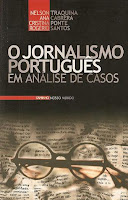
This paper is based exclusively on two published works, which originally were theses for a Master’s Degree: Ana Cabrera (2001) and Rui Marques (2005). The purpose of this paper is to reflect upon the recent history of a former Portuguese colony that became independent on 20 May 2002.
Theoretical concepts
1. In Ana Cabrera – pseudo-event in Daniel Boorstin (1971), applied to an event, the Peace Mission in Timor, lead by Rui Marques.
2. In Rui Marques – the agenda-setting in Kurt Lang and Gladys Engel Lang (1981), applied to sequential and interactive phases of the news on events in Timor.
Presentation of East-Timor
The Portuguese knowledge of East-Timor dates back to 1511. Dominican missionaries had built a fortress where Portuguese merchants made annual contacts with the Timorese, such as in sandalwood trade (Cabrera, 2001:204).
 After the union of the Portuguese and Spanish crowns, in 1580, Holland established itself in the western part of the island of Timor. Indonesia’s independence from Holland (1949), took the western part of the island of Timor under the control of Jakarta. Portugal, involved in its colonial wars since 1961, forgets about East-Timor. In 1974, when Portugal changed its regime, decolonization processes from the Portuguese empire take place: Angola, Mozambique, Guinea-Bissau, Cape Verde, São Tomé and Príncipe.
After the union of the Portuguese and Spanish crowns, in 1580, Holland established itself in the western part of the island of Timor. Indonesia’s independence from Holland (1949), took the western part of the island of Timor under the control of Jakarta. Portugal, involved in its colonial wars since 1961, forgets about East-Timor. In 1974, when Portugal changed its regime, decolonization processes from the Portuguese empire take place: Angola, Mozambique, Guinea-Bissau, Cape Verde, São Tomé and Príncipe.In East-Timor, political parties are set up and a civil war breaks out, with Fretilin, a political party of Marxist orientation, achieving victory in 1975. Indonesia invades and occupies the oriental part of the island. Portugal cuts diplomatic relations with Indonesia and the UN implores this country to leave. In October 1991, a Timorese student is assassinated. The people of Dili pay him homage in the Santa Cruz Cemetery. Indonesian troops fire on the crowd, killing several Timorese. There is a film that covers the massacre (12 November, 1991) and goes all over the world. Portugal organises a civic expedition to support East-Timor.
Insistent talks about the independence of the territory began, in which three persons would emerge: bishop D. Ximenes Belo and José Ramos-Horta, the present president of the Republic of East-Timor, having both won the Peace Nobel Prize, and Xanana Gusmão, the guerrilla leader and prisoner en Jakarta who, until recently, was the president of the Republic.
 In 1999 there is a referendum for the self-determination of East-Timor, with the victory of those who wish for independence. The pro-Indonesian militias, unsatisfied, destroy this small country’s infrastructures. In Portugal, there is a strong emotion over the events and a great civic action to uphold the cause of the people of East-Timor (meetings and silent manifestations with people all dressed in white, which produced images of a very strong symbolism).
In 1999 there is a referendum for the self-determination of East-Timor, with the victory of those who wish for independence. The pro-Indonesian militias, unsatisfied, destroy this small country’s infrastructures. In Portugal, there is a strong emotion over the events and a great civic action to uphold the cause of the people of East-Timor (meetings and silent manifestations with people all dressed in white, which produced images of a very strong symbolism).This very short summary prepares the analysis of the following agents/institutions:
1. Role of the Timorese patriots
2. Role of Portugal
3. Role of Indonesia
4. Role of the United States.
 Rui Marques notes that, besides Portugal, the Timorese patriots became aware of the importance of the media coverage of their situation, especially the information that reached the United States (and the UN).
Rui Marques notes that, besides Portugal, the Timorese patriots became aware of the importance of the media coverage of their situation, especially the information that reached the United States (and the UN).The United States were crucial in two moments of the East-Timor crisis. First, in 7 January 1975, Indonesia invaded East-Timor, the day after the American president Gerald Ford and his Secretary of State Henry Kissinger ended their visit to the country. Second, on 12 September 1999, a referendum in East-Timor gives victory to the sympathizers of self-determination of the country, opposing Indonesian rule. In the previous year, North American Congress (and the EU) upheld the self-determination of the territory. The interest that President Bill Clinton showed in the matter of East-Timor was crucial for the international change of attitude. This was also followed by an ideological change of the Timorese leaders, from Marxism to social-democracy.
(to be continued)

Sem comentários:
Enviar um comentário